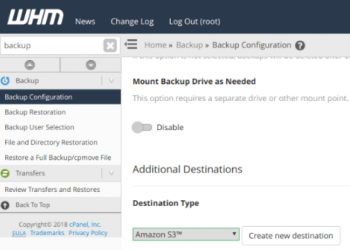Add a User to Sudoers on Debian 10 - Step by Step Process ?
This article covers how to add users into the sudoers group. Also you will learn how to edit rules in the sudoers configuration file through the command. You can customize the sudoers file based on the user requirements. Sudo stands for superuser do. Sudo is a command used in Unix-like systems to allow a regular user to execute a program as another user. In most cases, it is the root user.
The sudo command allows authorized users to perform commands as another user, which is by default the root user.
This option gives you administrator-level permissions to run programs on your machine. It is an alternative to using the su command.
Install Cockpit on CentOS 8 - Step by Step Process ?
This article covers how you can easily install Cockpit on your CentOS system and manage other Linux servers. With Cockpit, you can have a quick glance at the performance of all your added servers. Also, you can monitor system resources, start and stop services, shut down the system, install updates, view network activity (send/received). create or remove user accounts, access Terminal, and much more on the remote servers. Cockpit helps to save a lot of time by letting the administrators manage the remote servers that are spread across the network using a lightweight and intuitive interface.
Benefits of Cockpit in our GNU/Linux servers:
- It consists of systemd service manager for ease.
- It has a Journal log viewer to perform troubleshoots and log analysis.
- Storage setup including LVM was never easier before.
- Basic Network configuration can be applied with Cockpit
- We can easily add and remove local users and manage multiple servers.
To Install and enable Cockpit packages from repository, run the command:
$ sudo yum install cockpitType "y" and it will start downloading and installing the required packages.
To enable the Cockpit with the following command:
# sudo systemctl start cockpitor
$ sudo systemctl enable --now cockpit.socketTo confirm the status of Cockpit, run the command:
# sudo systemctl status cockpit
Migrate from CentOS 8 To Rocky Linux 8 - Step by Step Process ?
This article covers how to easily migrate to Rocky Linux 8.4 from CentOS 8. Rocky Linux is a community enterprise operating system designed to be 100% compatible with RedHat Enterprise Linux. Rocky Linux dev team has created a migration script called migrate2rocky to easily convert an existing CentOS 8 system to Rocky Linux 8.
To Upgrade the current CentOS 8 Linux system to latest available version, run the command:
$ sudo dnf --refresh upgradeAfter update is completed, Reboot your system:
$ sudo reboot
Install LAMP Stack on Rocky Linux 8 - Step by Step Process ?
This article covers how to install LAMP stack on Rocky Linux 8.4. You can now proceed to test or host your website and applications. A LAMP stack is a group of open-source software that is typically installed together to enable a server to host dynamic websites and web apps. This term is actually an acronym which represents the Linux operating system, with the Apache web server. The site data is stored in a MySQL database, and dynamic content is processed by PHP.
How to Install and configure Apache Web Server ?
1. First, we will start by installing the Apache web server. To complete the installation, use the following command:
$ yum install httpd httpd-tools2. Once the installation is complete, enable Apache (to start automatically upon system boot), start the web server and verify the status using the commands below:
$ systemctl enable httpd
$ systemctl start httpd
$ systemctl status httpd3. To make your pages available to public, you will have to edit your firewall rules to allow HTTP and HTTPS requests on your web server by using the following commands:
$ firewall-cmd --permanent --zone=public --add-service=http
$ firewall-cmd --permanent --zone=public --add-service=https
$ firewall-cmd --reload
4. Verify that the web server is running and accessible by accessing your server’s IP address:
$ echo "Hello there, Apache webserver is now running" > /var/www/html/index.html5. And restart tht Web Server to reflect the changes made:
$ systemctl restart httpdFrom your browser,
http://IP_addressHow to Install PHP on CentOS ?
1. To install PHP on your RHEL 8 use the command below:
$ yum install -y php-mysqlnd php-dom php-simplexml php-xml php-xmlreader php-curl php-exif php-ftp php-gd php-iconv php-json php-mbstring php-posix php-sockets php-tokenizer2. Now restart your web server so that Apache knows that it will be serving PHP requests as well:
$ systemctl restart httpd
Different methods to Find the Interface Link Speed in Linux Mint 20
This article covers the different ways you can easily find out the interface link speed of any specific interface in Linux Mint 20. IP command is similar to ifconfig, which is used for assigning Static IP Address, Route & Default Gateway, and so on.
Also the ethtool command is used to query or control network driver and hardware settings:
# ethtool eth0
Find Linux Server Geographic Location in Terminal - The best Method ?
This article covers how to get the geographical information of a Linux server via the command line. IP addresses provide an easy way to track the location of the server in the world by using two useful APIs provided by ipinfo.io and ipvigilante.com to get the city, state, and country connected with a server.
To get the IP address geographic location of the server, we need to install curl command line downloader and jq command-line tool to process the JSON data from the geolocation APIs:
$ sudo apt install curl jq #Ubuntu/Debian
$ sudo yum install curl jq #CentOS/RHEL
$ sudo dnf install curl jq #Fedora 22+
$ sudo zypper install curl jq #openSUSETo get the server's public IP address, use the following curl command to make an API request to ipinfo.io in your terminal:
$ curl https://ipinfo.io/ip















